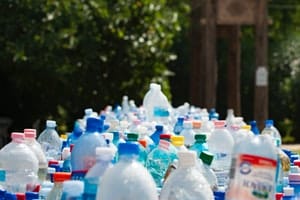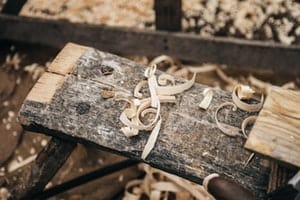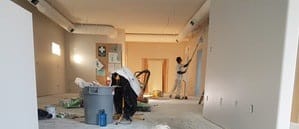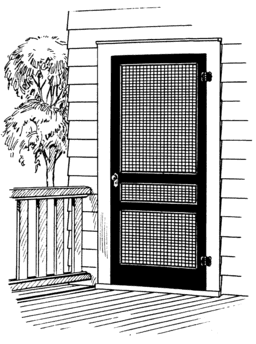Bees and yellow jackets are amazing creatures, however, they can both become a nuisance to humans as they try to enter, or eat, your home.
So, what can Bees and Yellow Jackets chew through? These insects chew through so many different types of materials. Both bees and yellow jackets can chew through wood, drywall, caulk, insect screens and expanding foam. Surprisingly neither insect can chew through all types of plastic.
Yellow jackets are sinister looking wasps with shiny, yellow and black bodies. They can look very similar to bees, but they are not bees at all. Yellow jackets are a type of wasp, and they typically eat other insects and nectar. Sweet foods and drinks will attract both bees and yellow jackets to your area.
Bees and yellow jackets will commonly build their nests in places that are inconvenient for you. Bees prefer to nest in trees or where there are flowers nearby but will build nests in the sidings of your home, under your porch or shed, in the cracks of cement found in your driveway or sidewalk, and many other places that you don’t pay much attention to. Yellow jackets will build their nests in their grounds sometimes. But their nests are commonly found in the walls of buildings and homes.
Both insects will attack you with no hesitation if you are seen as a threat to their nest. It can be very dangerous to attempt to get rid of these insects because they both have stingers and usually travel in groups. Since bees and yellow jackets are a threat to humans and their nests are commonly found too close to the living area, many people try to get rid of them using various methods.
Table of Contents
The Anatomy of Bees and Yellow Jackets
The anatomy of a bee or yellow jacket is like that of most flying insects. They each have a body, a head, legs and wings. But bees and yellow jackets are unique but similar to each other in the way that they chew. It may seem weird, but bees actually don’t use their teeth to chew. A bee’s teeth are located on their wings, they are used to connect their wings. This makes it easier for the bees to fly. Yellow jackets don’t have teeth at all.
How do bees and yellow jackets chew?
They use their mandibles. The mandibles are the two long sharp antennas that are attached to the head of the bee or yellow jacket. They are often referred to as the insect’s mouth because of its placement. The mandibles work by opening from side to side and works as the insect’s jaw. The sharp points of the mandibles allow bees and yellow jackets that to chew, cut, grasp, tear or squeeze anything objects that it needs or wants to. The mandibles are very important for the survival of bees and yellow jackets.
Bees and yellow jackets also use their mandibles as a defense to help protect themselves from other insects, their bites are painful to other insects. The mandibles are needed to gather and eat food. Yellow jackets eat other insects, so they also use their mandibles to grab, kill, and chew them.
Bees need their mandibles to gather and chew pollen, among other things. Bees and yellow jackets also use their mandibles to chew through material such as wood or drywall to get in or out of locations. Once they find a suitable location, the insects will use their mandibles to chew holes for their nests. Bees and yellow jackets need their mandibles to chew and perform essential life functions. They will use their mandibles to chew through anything that they can if they need to.
Can Bees and Yellow Jackets Chew Through Plastic?

Bees can chew through plastic but it depends on what kind of plastic it is. The bees will chew plastic, mostly plastic found from garbage bags. They will also chew plastic to get inside or outside of areas. Bees will commonly use chewed plastic as a material for their nest. Whether its chewed plastic bags or chewed plastic sealant, any kind of plastic that the bees can chew will be helpful towards building a nest. People commonly catch bees, and their nest, in plastic bags because they believe the bees can’t get out unless the bag is opened. However, this is not true and can lead to a very dangerous situation.
Yellow jackets can also chew through plastic, and they also gather plastic and chew it up to help contribute to their nest. Neither yellow jackets or bees can chew through the plastic of plastic bottles. Therefore, they are commonly used in efforts to get rid of bees or yellow jackets. When found in the house people often vacuum them into plastic bottles where they can’t get out to avoid vacuuming them straight into the vacuum bag. Bees and yellow jackets are also always being covered or trapped by all kinds of plastic things, like plastic cups or cake covers.
You can find plastic bottle traps online that tricks the bees and yellow jackets into falling directly into the plastic bottle on their way out of the nest entrance. The bees will die at the bottom of the bottle because they won’t have access to food.
Can Bees and Yellow Jackets Chew Through Wood?

Most bees can’t chew through wood, but carpenter bees can. In the spring time if you have carpenter bees around your house they will chew through the wood. Female carpenter bees will chew tiny round holes in the wood so that they can lay their eggs. Upon closer inspection, you can see that those tiny holes are actually tunnels. But she will prefer to lay her eggs where there’s softwood, so she can more easily drill her holes.
Some of the places female carpenter bees will commonly nest are in the house sidings, fascia boards, playgrounds, eaves and wooden furniture. A female carpenter bee will need approximately 5 or 6 days to drill through an inch of wood. Her nest is essentially a house where she will drill individual rooms to lay her eggs. If she continues to come back to the same structure, every year after hibernation it will begin to cause noticeable damage to your structures.
You can prevent carpenter bees by looking at the areas where the bees are commonly found around your house, you are looking for tunnels. As you see them treat with insecticides. Carpenter bees try to avoid treated wood. It also helps if the wood is painted and not decaying.
Yellow Jackets can easily chew through wood. In fact, they commonly do because they need the wood fibers to build their nest. The will chew the wood up and combine it with their saliva until it is the perfect texture to build with. The yellow jackets may build a nest in your wall or wall. They are also more likely to nest in rotting woods. During the spring, summer and early fall you should more aware, and check your property for yellow jackets.
If you find a nest of yellow jackets you can easily get rid of them by spraying it with a pyrethrum aerosol. The key is to find the nest during the day, to get a good idea of how it’s structured. But to wait until night to spray the nest. It is safer this way because the wasps are all home, at ease and can barely see you coming at night.
Can Bees and Yellow Jackets Chew Through Drywall?

Bees can and will chew holes through drywall. Drywall is the material that most people choose to use to build walls in their home. Bees will chew through the drywall anytime that they need to. Especially if you attempt to trap them in the wall by closing their entrances. Bees will chew through drywall to find material for building their nest, such as insulation.
They will also chew through drywall to create more doors for the nest. But bees aren’t likely to chew through drywall, simply because they don’t usually build their nest inside the house. Even if they do build a nest in the house it is more likely to be hanging in a corner than behind a wall. Yellow jackets can easily eat holes through the drywall.
During the spring and summer, this becomes a common problem, because yellow jackets will often decide to build nests in the walls of people’s home. Yellow jackets will also chew through drywall to create new entrances to the nest. Yellow jacket and bees’ nests tend to get bigger over time, so as the nests get bigger you may begin to hear them buzzing through the wall. If they’ve already begun chewing through the drywall to make additions to the nest you may notice the holes in your wall. It may take a nest of yellow jackets just a few days to chew through drywall. But it can sometimes take up to a few weeks. Bees will take a little longer. But both insects will chew through the drywall in time. They will often chew through the drywall to get out of a place or to get into one.
As a preventive method to keep bees and yellow jackets out of your wall, you should focus on ways to prevent them from entering the house. You can do this by sealing all entrances that they can use to enter, this includes cracks, windows, etc. If you have an attic, you should look especially carefully for entrances. There isn’t really a way to prevent bees and yellow jackets from chewing through drywall except to evacuate them. You can call pest control and they will likely vacuum them out of the wall.
Can Bees and Yellow Jackets Chew Through Caulk?
Bees can chew through caulk, sometimes. Caulk is a sealant used to seal up many kinds of material. It is commonly used to plug entrances made by bees. It is also used to seal holes and cracks in structures that bees can easily use to enter the house or may use as an entrance to their nest. Whether the bees can chew through it depends on the material. Caulk comes in many different combinations of materials depending on its purpose. It is advised that you use silicone caulk to reduce the chances of the bees chewing through it. The rubbery texture of the silicone when dry makes it harder to chew through. However, given enough time they still may.
Yellow jackets can also chew through caulk. This can be a huge issue because the yellow jacket nest usually contains thousands of yellow jackets. They will work together to chew through the caulk. How likely it is for bees and yellow jackets to chew through chalk depends on the materials the caulk is made up of. Professionals recommend killing the bees or yellow jackets with a suitable insecticide, then evacuating them. You should do this before you attempt to seal the holes, to prevent them from chewing through the caulk then angrily entering your home. Caulk is best used as a preventive method, to keep bees from entering the house.
You can prevent bees and yellow jackets from chewing threw caulk by adding another barrier inside the holes such as stainless-steel wool, a screen, or fiberglass insulation, then caulk over that material. Sealing up the nest entrances will also prevent new insects from using it as an entrance later on. If effectively used caulk is a great tool to protect your home structures from being attacked by bees and yellow jackets. It is never effective to seal a hole with live bees and/or yellow jackets with caulk because they can both chew through it with time.
Most professionals recommend not dealing with these insects by yourself at all, to just call an exterminator because it can be dangerous.
Can Bees and Yellow Jackets Chew Through Screens?
Yes, Bees can chew through most screens, but it depends on what material the screen is made of. Insect screens are mesh screens that are commonly used to cover windows, doors and other entrances to the area, as a method to keep flying insects out.
The standard insect screen is made of fiberglass. But screens come in a lot of different kinds of materials. You can purchase screens made of aluminum, copper, nylon, polyester, and more. But it’s important to get a strong material if you are up against bees. If you choose to get a standard fiberglass screen, the bees are more likely to chew through it. If the screen is made of a strong material such as metal, the bees won’t be able to chew through it.
Yellow jackets can also chew holes in screens that aren’t made of strong material. As you know carpenter bees and yellow jackets can both also chew through wood. It’s important to choose the frame of your screen wisely also. You should choose a frame made from strong material such as metal instead of wood. To prevent bees and yellow jackets from entering your home through screens, you should make sure that you tightly seal the screens.
Bees and yellow jackets will target screens that are already damaged. They can easily slip through areas where the screen is detaching from the frame, and any other place in the screen with a hole is big enough. That’s why you should also take the size of the holes in the screen into consideration. A screen with holes that are too big won’t work, because bees and other insects can slide through them.
When buying a screen as a method of protection against bees or yellow jackets be sure to get a quality screen made of strong material, preferably metal. Make sure to also get a frame made of strong material and be sure to tightly seal the screen into the frame.
Can Bees and Yellow Jackets Chew Through Expanding Foam?
Bees can chew through expanding foam Yellow jackets can chew through expanding foam also. Expanding foam is a spray that is used to seal cracks and holes, it expands and then hardens with time to create a hard, foam-like material, that is intended to keep insects and other things from getting inside an area. There is no question of whether bees or yellow jackets will be able to chew through expanding foam. Expanding foam is only effective temporarily and can be used to keep bees both from entering and exiting an area.
Bees and yellow jackets will chew through the foam to get out of where they’re sealed in, and the ones who got sealed out will chew through the foam to get back into their nest. However, the foam should only be used temporarily as a sealant until an exterminator or beekeeper arrives. If you decide to wait too long after applying expanding foam to call help, the bees will have chewed their way into home or back into their nests.
Expanding foam is also used to kill bees and yellow jackets. There is foaming spray made exactly for this purpose. In theory, if you spray it directly into the nest entrance, it will expand into the nests of the insects and kill them upon contact. However, this is only in theory, in reality, you may not reach all the bees or yellow jackets. This will leave the insects aggravated and alive, just trapped. As time passes the insects will find a way to get out, whether it be creating another entrance, or surviving until the foam has started to decay. After approximately 2- 3 weeks this foaming spray will lose its potency and become ineffective. The bees will then begin to chew through this foaming spray. You can use expanding foam spray for insects both inside and outside of the home.
Whether you are using expanding foam to seal bees or yellow jackets into an area, or to try and kill them: expanding foam is only efficient temporarily. Both bees and yellow jackets will chew through any kind of expanding foam if given time. Expanding foam should never be the only method used for defense. It is recommended to have a professional finish the job.
Most people underestimate bees and yellow jackets, especially when it comes to what type of material bees can get out of. Some people aren’t even aware of the fact that these insects not only, but they chew also. Common methods to get rid of these insects include sealing them in their hole with some type of material such as expanding foam, or caulk. But the bees or yellow jackets will escape by chewing through not only the materials used to seal the hole but also through the drywall or plaster of the wall. Some people will also attempt to keep these insects out with insect screens, however, that won’t always work either.
Conclusion
In order to keep bees out, you must get the appropriate materials, get materials that are created strong enough to last through the chewing. You can also decide to double up and use more than one method at a time. The best and safest method to get rid of bees or yellow jackets is to call a professional.
Bees and yellow jackets can both chew through wood, screens, caulk, drywall, and expanding foam. But they can rarely chew through plastic, if you use a plastic bottle as a trap, they are highly unlikely to chew through it.



